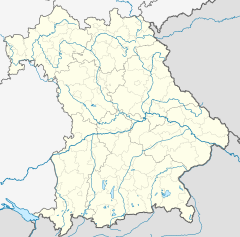
Summary
Pullach station is a station on the Isar Valley Railway from Munich to Bichl in the German state of Bavaria. It has been part of the Munich S-Bahn since 1981. The station is located in the municipality of Pullach, which also contains the stations of Großhesselohe Isartal and Höllriegelskreuth. It is classified by Deutsche Bahn as a category 6 station[3] and has two platforms. The station building is registered as a historic building on the List of Bavarian Monuments and has been acquired by the municipality of Pullach. It currently operates the station and is considering how the station building and the surrounding area could be used in future development, including aesthetic improvements.
| Through station | ||||||||||||||||
 | ||||||||||||||||
| General information | ||||||||||||||||
| Location | Pullach im Isartal, Bavaria Germany | |||||||||||||||
| Coordinates | 48°03′31″N 11°31′19″E / 48.058678°N 11.521933°E | |||||||||||||||
| Owned by | Deutsche Bahn | |||||||||||||||
| Operated by | ||||||||||||||||
| Line(s) |
| |||||||||||||||
| Platforms | 2 | |||||||||||||||
| Connections | ||||||||||||||||
| Other information | ||||||||||||||||
| Station code | 5057[3] | |||||||||||||||
| DS100 code | MPUL[1] | |||||||||||||||
| IBNR | 8004899 | |||||||||||||||
| Category | 6[3] | |||||||||||||||
| Fare zone | ||||||||||||||||
| Website |
| |||||||||||||||
| History | ||||||||||||||||
| Opened | 1891 | |||||||||||||||
| Services | ||||||||||||||||
| ||||||||||||||||
| Location | ||||||||||||||||
 Pullach Location in Bavaria  Pullach Location in Germany  Pullach Location in Europe | ||||||||||||||||
Location edit
Pullach station is located at Bahnhofstraße 10 in the municipality of Pullach between federal highway 11 and the high banks of the Isar River. At both ends of the station there are level crossings; the level crossing barriers are to be renewed and fully automated in April 2013. Two underpasses were planned years ago, but these plans have since been abandoned due to concerns about their impact on the local landscape.[5]
History edit
The Isar Valley Railway opened from Thalkirchen to Ebenhausen on 10 June 1891 and it was extended to Wolfratshausen on 27 July. Initially, there was a railway station in Pullach, which was known as Isartalbahnhof (station of the Isar Valley Railway) because it was served by trains running on the Isar Valley Railway. Duplication of the track from the station of the Isar Valley Railway (Isartalbahnhof) in Munich to Höllriegelskreuth was completed on 23 December 1897. Pullach station consequently had three tracks, with tracks 2 and 3 being used by passenger trains. Track 1, next to the station building, was used mainly for freight and was equipped with a loading siding and a small freight shed. The station was electrified on 15 January 1900, alongside the Munich-Isartalbahnhof–Höllriegelskreuth section of the Isar Valley Railway. In 1944, Pullach station was served by 44 commuter trains, mostly suburban services between Munich Isartalbahnhof and Höllriegelskreuth.[6] In 1973, the station facilities were rebuilt for its integration into the Munich S-Bahn network and one track was demolished. The remaining two side platforms were raised to a height of 76 centimetres.[5] After the renovation, the station was served every 30 minutes by locomotive-hauled suburban trains, S-Bahn line 10, running between Munich Central Station (Hauptbahnhof) and Wolfratshausen. Since 31 May 1981, the station has been served every 20 minutes by electric multiple units on line S7; this was made possible by the construction of the southern lines tunnel (Südstreckentunnel).[7]
Operations edit
The station has two side platforms that are 140 metres long and 96 cm high.[8] There are level crossings situated at both ends of the platforms.[9] The S-Bahn station is served by S-Bahn lines S7 from Wolfratshausen to Kreuzstraße every 20 minutes and S20 from Höllriegelskreuth to Pasing hourly from Monday and Friday.
Station building edit
The single-storey station building is located between two two-storey pavilions. The station building's pavilions are plastered buildings with exposed brick decor and have hip roofs; the middle part has a flat roof. The platform hall is situated between the pavilions, which is aligned next to the platform. It is supported by three cast iron pillars. The station building is now registered as a historic building on the List of Bavarian Monuments.[10]
References edit
- ^ a b Eisenbahnatlas Deutschland (German railway atlas) (2009/2010 ed.). Schweers + Wall. 2009. ISBN 978-3-89494-139-0.
- ^ "S-Bahn, U-Bahn, Regionalzug, Regionalbus und ExpressBus im MVV" (PDF) (in German). MVV. December 2021. Retrieved 2 March 2022.
- ^ a b c "Stationspreisliste 2024" [Station price list 2024] (PDF) (in German). DB Station&Service. 24 April 2023. Retrieved 29 November 2023.
- ^ "S-Bahn, U-Bahn, Regionalzug, Tram und ExpressBus im MVV" (PDF). Münchner Verkehrs- und Tarifverbund. December 2019. Retrieved 1 March 2020.
- ^ a b "Description of Pullach station" (in German). Die Isartalbahn im Internet. Retrieved 15 March 2013.
- ^ "Railway timetable of 1944" (in German). Retrieved 15 March 2013.
- ^ Claus-Jürgen Schulze (1978). Die Isartalbahn (in German). Munich: Bufe-Fachbuchverlag. ISBN 3-922138-04-7.
- ^ "Platform information of Pullach station" (in German). DB Konzern. Archived from the original on 23 September 2015. Retrieved 15 March 2013.
- ^ "Map of the station area, showing the S-Bahn station, bus stop, and disabled access" (PDF) (in German). MVV. Retrieved 27 March 2013.
- ^ "Pullach station" (in German). Bayerischen Landesamt für Denkmalpflege. Archived from the original on 14 April 2016. Retrieved 15 March 2013.
Sources edit
- Georg Paula, Timm Weski (1994). "Landkreis München". In Bayerisches Landesamt für Denkmalpflege (ed.). Denkmäler in Bayern: Kreisfreie Städte und Landkreise (in German). Vol. I.17. Munich: Karl M. Lipp Verlag. p. 232. ISBN 3-87490-576-4.
- Claus-Jürgen Schulze (1978). Die Isartalbahn (in German). Munich: Bufe-Fachbuchverlag. ISBN 3-922138-04-7.
External links edit
- "Description and plans of the station" (in German). BEG. Retrieved 26 March 2013.


